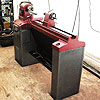What is the acceptable gap between pins and tails in half blind dovetails (I’m doing hard maple)?
I am able to get my gaps so close that I can barely slip .0015” feeler stock in – is this too tight? I love the way it looks though - but would it cause the stock to split in time after gluing?




 Reply With Quote
Reply With Quote










 ).
).


